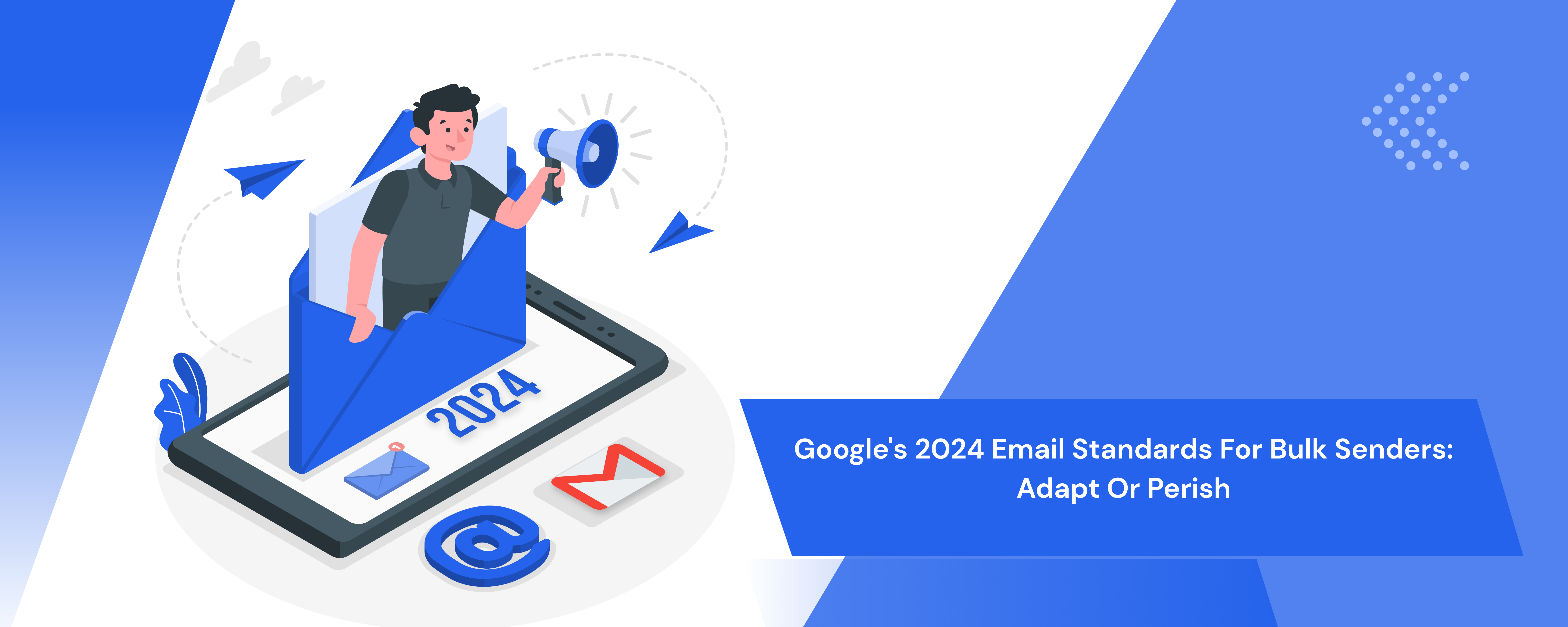Emails are crucial to daily business routines, from sending marketing content, promoting products and services, to sharing valuable information with your audience.
Leveraging emails, businesses indulge in powerful marketing strategies that generate leads and possibly convert your audience into buyers.
In a 2022 poll, half of marketing professionals claimed to have doubled their ROI through email marketing.
This kind of achievement is possible through consistent mailings and marketing content.
Learn how from our beginner’s guide to email marketing.
Only, it can go haywire as ambitioned marketers try to oversell their products by sending out unsolicited blast emails that end up in spam.
To avoid any more spamming, Google has refined its sender guidelines for bulk mail and has set requirements for marketers and agencies to follow. This will be enforced in February 2024.
If you work on email blasts sending 5000 or more emails daily, you may want to read this article about Google’s new update and implement solutions according to the guidelines.
Forfeit this and you may get spammed!
Bulk Emails
Bulk emails are sent when your company invests in email marketing campaigns and has a larger audience base. Newsletters, product promotion emails, lead campaigns, and company announcements are usually sent as mass mail.
According to Google’s requirements, the spam rate must be under 0.3% in Google Postmaster Tools.
Postmaster Tools help gather data on bulk emails sent, including delivery errors and spam reports. The tool is beneficial when tracking email campaigns and analyzing data to understand why certain emails are considered spam.
Security and Defense Systems of Gmail
Google has developed guidelines for mass email senders, to reduce spam rates and furnish a secure experience. As a provider, it uses strong security and defense systems that senders must adhere to.
One of the foremost levels of security that Google enables is encryption through TLS connection.
Transport Layer Security is the most-used and preferred security measure to protect user data privacy. Mails must be encrypted with TLS security protocol to ensure they are safely secured before being sent.
Gmail also relies on text classifier models to track spam, phishing, and scams.
One of the defense systems of Google, RETVec is a recently released text vectorizer for those classifier models built to identify scams and help lessen scammers evading from classifiers. Simply, it is an AI-powered spam detection tool.
Google analyzes incoming emails and categorizes them as either legitimate or spam.
This has been possible due to the development of machine learning in the past few decades, which takes in user input to distinguish spam from other mail.
All of these remind us that fraudulent activities can be avoided and attacks can be strongly defended. Additionally, Google sets guidelines for bulk senders especially to stop spam.
Google’s New Rules for Bulk Email Senders
Google sets the following guidelines that focus on three aspects:
1. To authenticate email senders
2. To enable unsubscription
3. To avoid unsolicited emails
1. Authentication Requirements
Bulk senders are usually marketers who need to get a message across to a large audience base.
Google’s new update requires bulk senders to use established protocols besides TLS encryption, such as SPF, DKIM, and DMARC protocols.
Sender Policy Framework (SPF) ensures the mail servers that are authorized to the domain only get to send the emails. This helps receiving servers to spam any mails pretending to come from your company.
DomainKeys Identified Mail (DKIM) serves the same purpose to stop mails from your impersonators, through digital signature features.
They help in increasing the deliverability of your mails.
Lastly, DMARC checks the above two processes and marks the email as spam.
The Postmaster Tools Authentication dashboard provides detailed information on SPF and DKIM authentication.
DMARC can be checked using third-party authentication tools.
Together, SPF, DKIM, and DMARC help domain owners avoid attackers sending emails using their domain and stop other fraudulent activities like spoofing.
2. Enable Unsubscription
Imagine receiving emails repeatedly from a sender you no longer take interest in.
This will go against the community guidelines much like the Uber spam scandal. Uber was fined $412,500 in Australia for sending 2 million emails in an unsolicited email blast, with no option to unsubscribe.
Hence, make sure to include an “unsubscribe” button in all your email campaigns.
3. Solicited and Wanted Emails
Moreover, Google plans to set a clear spam rate threshold that domains mustn’t exceed.
It can be tracked in Postmaster Tools.
This is to ensure whether the emails that Gmail users receive are wanted or not. The quality of your content and the value you add through it will ultimately decide your subscription rate and ‘wantedness’.
Other Requirements to Increase Deliverability
Messages may end up undelivered if the sender’s details are hidden. Google also advises against using URL shorteners as links to malicious websites can be hidden in them.
To stay within the daily quota assigned by Google, use Google Cloud Console to know your limits for every project.
Google suggests using separate email addresses for different purposes such as promotional emails and transactional emails or sending emails from different domains.
For third-party senders, any violation by the clients should be actively monitored and reported.
Conclusion
The following can be ensured if the guidelines are checked and ruled by you.
It is as important to get your email outreach to build audience as it is to adhere to Google’s new guidelines. Use GoZen Growth platform to automate email marketing and monitor the entire process.
GoZen Growth complies with guidelines like the GDPR and ensures users follow the protocols for authenticity. It also comes with inbuilt warm-up tools that send emails periodically and make sure they do not end up in spam. So, get aboard and avail the benefits.
FAQs
How to avoid being flagged as spam in Gmail?
What are the tools to automatically set SPF, DKIM, and DMARC for Gmail?
The following tools enable generators for SPF, DKIM, and DMARC,
DmarclyEasyDMARC
Dmarcian
How to make your Gmail secure? (for small businesses)



